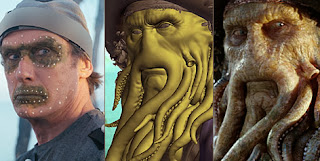One of the wonderful thing about films these days is that pretty much anything can be created nowadays to be able to create something exciting and creating anything that comes to mind, providing you have a load of skilled specialists at your fingertips ready and waiting.
The first thing that I wanted to look at is probably one of the most common techniques known in the industry and that is motion capture. Motion capture is a technique used to record the movement of objects or people. It is now used in a wide variety of things for different reasons, but for this module I am most interested in how it can be used in film production. In film making is can record the actions of actors and use the data it collects to be able to animate digital 2D or 3D models onto it using computer animation. This can include facial capture and even small subtle expressions. Previously motion capture was used to record only the movement of an actor and not there physical appearance, in which the data is then mapped to a 3D model so that they can perform the same actions.
There are many advantages and disadvantages to using motion capture, each carry there own fair points and it can be useful to know before starting out with using it in a film.
Advantages
- Real time results can be achieved which can reduce costs of keyframe animation
- It allows many tests to be done and carried out
- Complex movements and interactions can be easily captured
- A lot of animation data can be produced within a short amount of time
Disadvantages
- Specific hardware and programs are required
- The cost of software, equipment and crew can be a lot for a small production
- You may need a lot of space to shoot in due to camera field of view
- If something goes wrong you will have to reshoot, as it's easier than changing the data
- Movement that does not follow the laws of physics cannot be captured
- Traditional animation techniques have to be added in later
Motion capture primarily started in the 70s and 80s from research that was carried out to help technology mature, and since then different techniques have been used to perfect it and help to make it better. Probably the most common way is that the actor wears markers on each joint to identity movement and these are then tracked and marked down as the actor does his performance. Optical systems are a slightly different way of producing this, but by using image sensors to map out 3D positions from one or more camera to provide overlapping projections. This can then be used to track a large number of performers by adding in more cameras. We then also have something called active optical systems which are used to map positions this time by illuminating LED lights in quick succession to identify where they are. This is used mainly on the face of an actor to triangulate the smaller details that will move and is more commonly used in the film The Lord of the Rings in how they portray Gollum, as they will use the facial movements of Andy Serkis and map this onto the model.
Pirates of the Caribbean
Another fantastic example of how motion capture can be used is in the Pirates of the Caribbean films and more importantly in Davy Jones crew. These films are brilliant to watch if you have a massive interest in motion capture as it uses it to its full advantage. Seeing images when the cast are on set is so weird as you expect to see them as the Davy Jones crew and not the blue jumpsuit with markers on there face crew.. It's rather surreal and odd to see but it makes sense to use this technique instead of getting them in ridiculous costumes, that would probably take all day to get on, every single day they needed to shoot.
The Polar Express
So this Tom Hanks orientated film is another brilliant example of how motion capture can be used but this time to create an animation instead. The film is centered around the actors first, having them act out each scene whilst being motion captured and then composited into a CG world in which everything is now an animation following camera movements and also tracking facial expressions. It is a much simpler way to create an animation that requires this much detail in it.





No comments:
Post a Comment